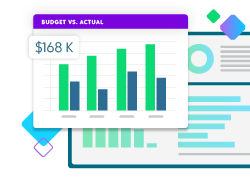5 Common Questions About Calculating Your Nonprofit’s Indirect Cost Rates

Nonprofit organizations are beginning to use indirect costs more frequently in their budgeting processes, whether or not they are pursuing government grants. Indirect costs are the costs that cannot be associated with one program or service within an organization (i.e., operating costs). Calculating indirect costs can assist organizations in accounting for the full cost of impactful programs.
Indirect costs can be confusing because there is conflicting information about indirect cost rates for nonprofits, what is considered an indirect cost, and how to calculate the costs. Nonprofits are often justified in their confusion about indirect costs because government agencies and foundations have different policies and rules around indirect costs, so there is more than one way to calculate a cost.
Not sure if your organization’s stakeholders are ready to incorporate indirect costs into your planning? Check out the blog post, Making a Case for Calculating Your Nonprofit’s Indirect Costs.
Below are five frequently asked questions related to indirect costs to help organizations identify how to calculate and allocate indirect costs.
1. What expenses are included in indirect costs for a nonprofit?
Indirect costs include everything that is not directly related to a particular program or service. When funders request your “project budget” or “program budget,” they are often requesting your direct costs—or the cost associated with offering your programmatic intervention. For example, some direct costs associated with an afterschool program at a local community center include food for snacks, supplies for arts and crafts, sports equipment for outdoor activities, and the costs of the staff members providing the programs.
If your organization follows best practices for nonprofit accounting, it will have a statement of functional expenses that often sorts expenses into three categories:
- Program Services
- Management and General
- Fundraising Expenses
This breakdown is also on the Statement of Functional Expenses included in your organization’s annual 990. Program services are the direct costs, while management/general and fundraising expenses are considered indirect costs—important costs that are necessary to run an effective organization.
2. How do you split costs among functional expenses?
The primary way to allocate the costs to the different functional expense categories is using resource allocation (or percentage allocation) based on time and function. For example, Colleen is a program director at the local community center that offers senior programs and afterschool programs for youth. Many nonprofit professionals wear different hats, so allocating an employee’s time helps create program budgets and calculate indirect costs. Colleen spends about 25% of her time supporting the senior programs, 50% supporting the afterschool programs, and then 25% working on fundraising efforts to support the community center. Therefore, 75% of Colleen’s time is considered a program expense (direct cost), and 25% is considered fundraising (indirect).
Allocating staff members’ time is not very complicated, and it is often an estimate. Organizations can conduct a time study to determine the amount of time folks spend on specific tasks and projects. But for budgeting purposes, using your best judgment is acceptable—as long as you recognize that the percentages may fluctuate throughout the year.
3. What about costs that are not salaries or other clearly allocated expenses?
When it comes to other expenses, they are not always evenly split. Allocating employee time is the best place to start because other office expenses can follow. For example, the community center employs 10 staff members: three are management and seven are primarily program staff. Therefore, office expenses such as phone, internet, technology, and office supplies can potentially be split 30% toward management and general expenses and 70% towards programs because individuals use them within that area of the organization. Your bookkeeper likely does not want to spend time determining whether management or programs purchased paperclips, so creating a policy of categorizing expenses is helpful.
Other expenses, however, can clearly be tied to each organizational function. If 1,500 flyers are ordered to promote a summer block party, then that printing cost is tied to a program function, while 500 direct mail letters to potential donors is a printing cost associated with fundraising.
Blackbaud Financial Edge NXT®
Accounting software built for grant compliance—no workarounds needed. Get 6 months FREE!
4. How does my nonprofit organization get an approved indirect cost rate?
Organizations should calculate their indirect cost rate based on the accounting practices, policies, and procedures adopted by the organization; however, getting an approved indirect cost from the government is quite a confusing journey. First, your organization must calculate its indirect cost rate using the guidance provided by its cognizant agency (i.e., the agency that provides it with the most funds).
When applying for government funding, your organization can include a preliminary indirect cost rate in its budget, and then it must go through the approval process for the indirect cost after it receives the funding. Organizations cannot get an approved rate until it is approved to receive funding. Your organization would go through its cognizant agency because once it receives an approved indirect cost rate from that agency, it is accepted by all other agencies. In most cases, government grants will allow an organization to request a 10% indirect cost rate without providing additional documentation, but if a nonprofit has an indirect rate higher than that, it is in the organization’s best interest to go through the approval process—which is not overtly complicated if the organization has strong accounting practices.
5. What is the ideal indirect cost rate for a nonprofit?
This is a question that does not have a simple answer because each organization’s indirect cost will be reflective of its mission and structure. An organization providing homeless services will likely have a lower indirect cost than a community development organization because most shelter costs are program costs, while an organization focused on community development may spend most of its time raising awareness or fundraising for other organizations within the community.
Conversations around overhead and the fact that funders need to cover the full cost of programs are increasing, and some scholars have reported that organizations may need to spend more than one-third of their budget on overhead costs to be effective. An organization’s indirect cost rate is insignificant, but the justification for expenses is an important part of the discussion. Organizations need to justify their expenses and how they help achieve community outcomes.
Create More Impactful Programs by Calculating Your Nonprofit’s Indirect Costs
When you know your nonprofit’s indirect cost rate, you can more accurately forecast and budget for additional programs and funding requests. When you don’t include your indirect cost rate, you are left scrambling mid-year to cover important expenses, such as salaries and rent.
Want to learn more about how to change the conversation about indirect costs at your organization? Check out the white paper, Accounting for the Full Cost of Impactful Programs: Calculating Indirect Costs for Your Nonprofit.
Fund Accounting Software that Drives Impact
Find out how Blackbaud’s Financial Edge NXT® fits your organization.




